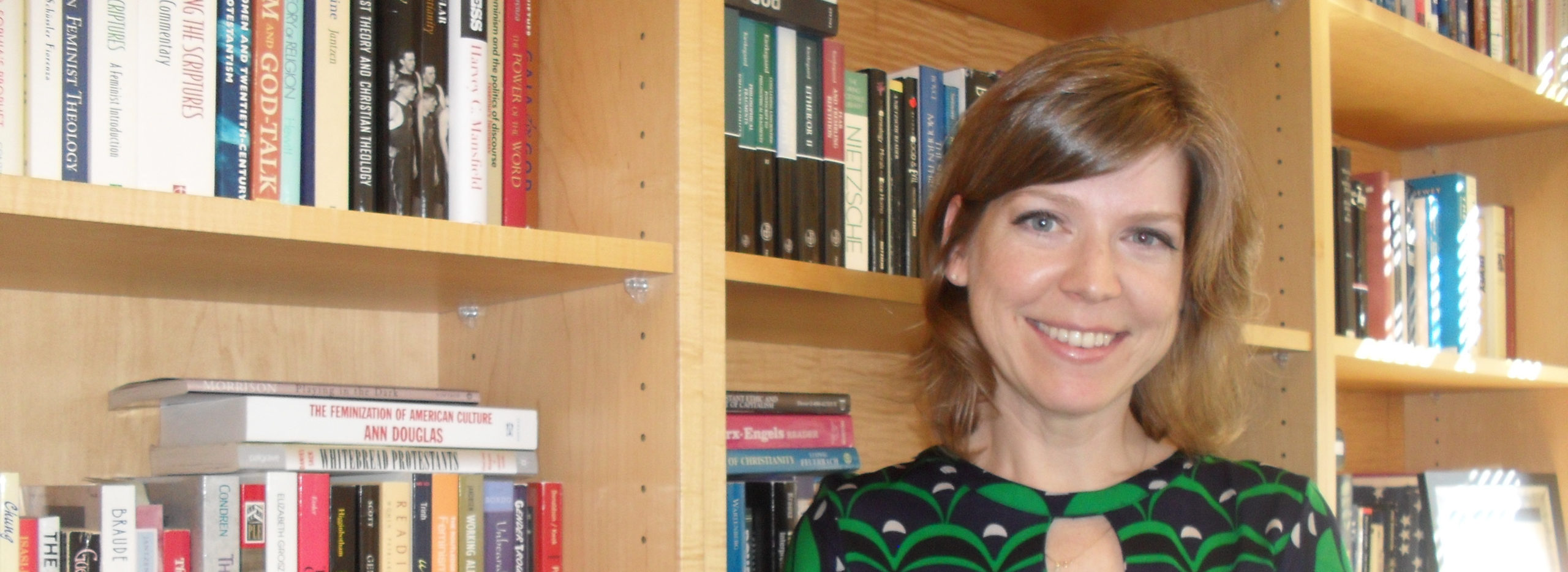Please say a bit about your past experiences. How would you describe your education, research and positionality?
Within the field of religious studies, which is my primary disciplinary home, I work in the area of religion and North American culture. I use textual analysis to explore ways that religious and cultural discourses intersect and the kinds of public claims that these discourses make, in contexts ranging from philosophical texts, historical documents, legal texts and popular culture to media and modern technologies. I specialize in the history of Protestant thought in the United States from the post-Civil War era to the present. My graduate training in North American philosophy, modern Western religious thought, hermeneutics, cultural theory and gender theory culminated in my first book, William James, Pragmatism, and American Culture (2016), which takes up the themes of religion, gender and nation in the work of the Harvard philosopher and psychologist William James and the American pragmatist tradition. Within the area of religion and media studies, I have focused on popular media and public forms of religious discourse in contemporary US evangelical Protestantism, examining topics such as gender, sexuality, representations of motherhood, grief and infant loss, apocalypticism, food practices, and authenticity and fraud. My current book project, provisionally titled Christian Evangelicals and Digital Media: The Mediated Gospel in America, takes up larger issues around evangelicalism and public discourse in the United States, including gender, sexuality, and nationalism.
William James is not often thought of as a thinker on media, but do you find that his work offers insights media scholars could learn from?
I do! There is an existing tradition of pragmatist communication theory developed by James Carey, Robert Craig and others. One of my articles tries to bridge my interests in James and media and communication studies by exploring the question of religion and/as communication as an animating theme in his work, reading two major texts, The Varieties of Religious Experience and Essays in Psychical Research (an under-studied collection of his writings on the paranormal) together. I am continuing to develop this line of inquiry into what I hope will become a larger project on rhetorics of supernatural speech and practices of discernment in religious traditions such as evangelicalism and spiritualism where people regularly claim to receive divine or supernatural communications.
Has the advent of the Trump era changed how you approach evangelical media?
Nationalism has become an increasingly dominant theme in my work since the election, and particularly the connections between US evangelicalism, white nationalism, and masculinity, which are now more obvious than ever.
How do you think contemporary feminism affected discourse in and on religion?
I can’t speak to this question in its entirety, but a few thoughts come to mind. First, third-wave feminism tends to be more secular than earlier waves. Sometimes, this manifests as a rejection of particular forms of religion seen as irredeemably patriarchal and sometimes as hostility toward religion in general. Sometimes, it is framed as a rejection of religion in favor of spirituality, as in the common phrase “I’m spiritual but not religious” that has become so culturally pervasive. Feminist spirituality, in this sense, usually locates itself outside of established religious institutions and traditions and tends to embrace newer forms of religious identity and practice that have developed in the modern West. For example, a recent anthology on third-wave feminism and religion, Feminist Spirituality: The Next Generation (2009), edited by Chris Klassen, focuses almost entirely on new religious movements such as Goddess spirituality, paganism and witchcraft. In this way, third-wave feminism is in line with larger cultural and generational shifts away from organized forms of religion and toward more fluid, hybrid, individualistic forms of meaning and practice.
How could experiences of public engagement facilitate how journalists and religious scholars communicate and understand each other? Do you see social media facilitating this communication?
Many religious studies scholars have expressed frustration that religion is often not well understood in the media for various reasons, partly because of misunderstandings or assumptions about religion and partly because journalists often lack training in religious studies. At the same time, religious studies scholars often do not have media training and might feel reticent to engage with journalists because of concerns about how their work might be misrepresented or how more complex, nuanced points might be edited into soundbites. They may also be worried about how public engagement is valued or not valued by their peers and home institutions. In our Hypermediations project, the working group has been discussing these and other obstacles to public engagement today. In a hypermediated age—one in which people increasingly come to rely on social media for information and communication, one in which we are all immersed in a dizzying proliferation of networks and flows and one in which our teaching and research are very much connected to current political and social issues—we seek to explore ways in which the fields of religious studies and media studies can find common ground around a range of theoretical and practical issues related to public scholarship and open up new pathways for collaboration and exchange.
How does secularism affect the media’s coverage of religion in this media moment? What religious issues are underrepresented or misrepresented in media today? In scholarship?
The so-called secularization thesis — the idea that as societies become more modern, more educated and more politically and economically stable, religion will gradually disappear — cast a long shadow over the 20th century. Print and broadcast media have often reflected these ideas in their coverage of religion. This has meant, for example, that coverage of political unrest, war or violence tended to emphasize political, economic, and cultural factors much more than religious ones. Or that the rise of forms of religious fundamentalism in the late 20th century (such as the Religious Right in the US, Hindutva in India, and the Iranian Revolution) was treated as a kind of deviant aberration from the obvious progressive march of world civilization, away from religion and toward more modern and enlightened ways of thinking. Much empirical evidence and scholarship have critiqued and discredited the secularization thesis since then. But this is not to say that secularism is irrelevant or nonexistent.
On the contrary, the challenge today for both media producers and scholars is to try to come to terms with the impact of secularism in the modern world while also accounting for the forms of religious belief and practice that persist and even thrive alongside it. Talal Asad has argued that religion is “a modern concept not because it is reified but because it has been linked to its Siamese twin ‘secularism’”; in other words, that in the modern era, “religion” and “secularism” are co-constituted discourses. This means, for example, that forms of religion that persist today, including forms of religious fundamentalism, are explicitly constituted as oppositional to “the secular,” and vice versa. However, we should also be attentive—as an increasing number of scholars are today—to new forms of religious practice and identity that are fully compatible with secularism, such as the forms of spirituality mentioned above. In other words, in a secular age, religion has not disappeared, but it has taken new forms. Our challenge and our task as scholars and media producers is to be attentive to them.
Interviewed by Tammy Rae Matthews

